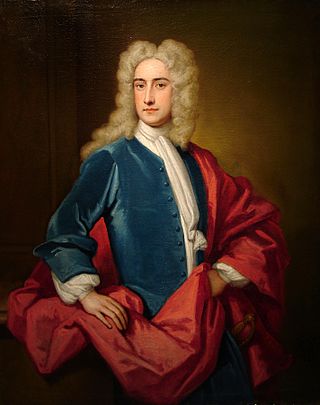Duke of Buckingham, referring to Buckingham, is an extinct title that has been created several times in the peerages of England, Great Britain, and the United Kingdom. There were creations of double dukedoms of Buckingham and Normanby and of Buckingham and Chandos. The last holder of the dukedom died in 1889.

Earl of Lichfield is a title that has been created three times, twice in the Peerage of England and once in the Peerage of the United Kingdom (1831). The third creation is extant and is held by a member of the Anson family.
The Peerage of the United Kingdom is one of the five Peerages in the United Kingdom. It comprises most peerages created in the United Kingdom of Great Britain and Ireland after the Acts of Union in 1801, when it replaced the Peerage of Great Britain. New peers continued to be created in the Peerage of Ireland until 1898

Viscount Cobham is a title in the Peerage of Great Britain that was created in 1718. Owing to its special remainder, the title has passed through several families. Since 1889, it has been held by members of the Lyttelton family.

The titles of Earl of Hertford and Marquess of Hertford have been created several times in the peerages of England and Great Britain.

Marquess of Downshire is a title in the Peerage of Ireland. It was created in 1789 for Wills Hill, 1st Earl of Hillsborough, a former Secretary of State.

Earl of Halifax is a title that has been created four times in British history—once in the Peerage of England, twice in the Peerage of Great Britain, and once in the Peerage of the United Kingdom. The name of the peerage refers to Halifax, West Yorkshire.

Baron Dacre is a title that has been created three times in the Peerage of England, each time by writ.

Earl of Drogheda is a title in the Peerage of Ireland. It was created in 1661 for The 3rd Viscount Moore.

Earl of Plymouth is a title that has been created three times: twice in the Peerage of England and once in the Peerage of the United Kingdom.
Viscount Hampden is a title that has been created twice, once in the Peerage of Great Britain and once in the Peerage of the United Kingdom. The first creation came in the Peerage of Great Britain when the diplomat and politician Robert Hampden, 4th Baron Trevor, was created Viscount Hampden, of Great and Little Hampden in the County of Bedford on 14 June 1776. The title of Baron Trevor, of Bromham, had been created in the Peerage of Great Britain in 1712 for his father, the lawyer Sir Thomas Trevor. Both titles became extinct in 1824 on the death of the first Viscount's second son, the third Viscount.

Baron Sandys is a title that has been created three times, once in the Peerage of England, once in the Peerage of Great Britain and once in the Peerage of the United Kingdom.

Earl of Clanricarde is a title that has been created twice in the Peerage of Ireland, first in 1543 and again in 1800. The former creation became extinct in 1916 while the 1800 creation is extant and held by the Marquess of Sligo since 1916.

Viscount Clifden, of Gowran in the County of Kilkenny, Ireland, was a title in the Peerage of Ireland. It was created on 12 January 1781 for James Agar, 1st Baron Clifden. He had already been created Baron Clifden, of Gowran in the County of Kilkenny, in 1776, also in the Peerage of Ireland. The Viscounts also held the titles of Baron Mendip in the Peerage of Great Britain from 1802 to 1974 and Baron Dover from 1836 to 1899, when this title became extinct, and Baron Robartes from 1899 to 1974, when this title became extinct, the two latter titles which were in the Peerage of the United Kingdom. The interrelated histories of the peerages follow below.

Viscount Dungannon is a title that has been created twice in the Peerage of Ireland. The first creation came in 1662 when Marcus Trevor was made Baron Trevor, of Rostrevor in the County of Down, and Viscount Dungannon. These titles became extinct on the death of the third Viscount in 1706.

Arthur Edwin Hill-Trevor, 1st Baron Trevor, styled as Lord Edwin Hill until 1862 and as Lord Edwin Hill-Trevor from 1862 to 1880, was a long-standing Anglo-Irish Conservative Member of Parliament.
County Down was a constituency represented in the Irish House of Commons until 1800.
Arthur Hill-Trevor, 1st Viscount Dungannon, was an Irish politician.

Arthur Hill, 2nd Marquess of Downshire PC, FRS, styled Viscount Fairford until 1789 and Earl of Hillsborough from 1789 to 1793, was a British peer and MP.

Mary Hill, Marchioness of Downshire and suo jure1st Baroness Sandys, was a British peeress.












